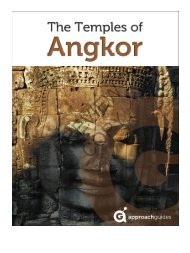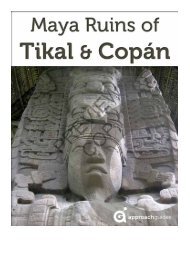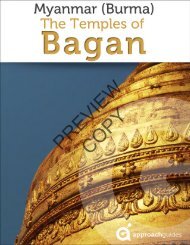Spain Revealed: Granada Alhambra - Approach Guides
Spain Revealed: Granada Alhambra - Approach Guides
Spain Revealed: Granada Alhambra - Approach Guides
Create successful ePaper yourself
Turn your PDF publications into a flip-book with our unique Google optimized e-Paper software.
PREVIEW<br />
COPY
Introduction<br />
Travel guidebooks for the ultra curious, <strong>Approach</strong> <strong>Guides</strong> reveal a destination’s essence by exploring<br />
a compelling aspect of its cultural heritage: art, architecture, history, food, or wine.<br />
The <strong>Alhambra</strong> — a magnificent 14th century palace-city built by the Nasrids in the city of <strong>Granada</strong><br />
— stands as one of the greatest monuments of Islamic <strong>Spain</strong>, or Al-Andalus. Using elaborate mosaic<br />
decoration that creates the impression of infinity, inscriptions that tell of the greatness of God, and<br />
walled gardens that symbolize Quranic paradise, the Nasrids realized a divine vision on earth. It is<br />
yours to discover.<br />
What’s in this guidebook<br />
• Comprehensive look at the <strong>Alhambra</strong>’s art and architecture. We examine the defining<br />
characteristics of the Nasrid style, isolating key features and concepts that you will see<br />
again and again as you make your way through the <strong>Alhambra</strong>; we tell you what makes them<br />
unique and what they symbolize. To make things come alive, we have packed our descriptions<br />
with high-resolution images.<br />
• A tour that goes deeper on the most important sites. Following our tradition of being<br />
the most valuable resource for culture-focused travelers, we provide a unique, detailed tour<br />
of the <strong>Alhambra</strong>’s premier sites, with a special focus on the Nasrid palaces. For each site, we<br />
provide information on its history, a detailed plan that highlights its most important architectural<br />
and artistic features, high-resolution images, and a discussion that ties it all together.<br />
• Advice for getting the best cultural experience. To help you plan your visit, this guidebook<br />
offers logistical advice and provides links to online resources. Plus, we provide our<br />
personal tips for getting the most from your experience while on location.<br />
• Information the way you like it. As with all of our guides, this book is optimized for<br />
intuitive, quick navigation; information is organized into bullet points to make absorption<br />
easy; and images are mocked up with text that explains important features.<br />
PREVIEW<br />
COPY<br />
Contact us anytime<br />
Our readers are our greatest inspiration. Email us at founders@approachguides.com to let us know<br />
about your experience with <strong>Approach</strong> <strong>Guides</strong> — many of our recent updates have been inspired by<br />
customers like you. We personally respond to every email.<br />
We hope that this cultural guidebook offers you fresh insights into <strong>Spain</strong>’s Islamic art and architecture<br />
and sets you on a path to making your own discoveries.<br />
Have a great trip!
David and Jennifer Raezer<br />
Founders, <strong>Approach</strong> <strong>Guides</strong><br />
www.approachguides.com<br />
Discover <strong>Spain</strong> with <strong>Approach</strong> <strong>Guides</strong><br />
Córdoba, the city where Islam got its start in <strong>Spain</strong>, is home to one of <strong>Spain</strong>’s greatest Islamic sites:<br />
la Mezquita, or the Great Mosque of Cordoba. Download our guide to Córdoba’s Mezquita to explore<br />
its stunning architecture.<br />
One of our favorite things about <strong>Spain</strong> is discovering its wines. Each region has unique grape varieties,<br />
terroir, and traditions that impact the flavors and styles of its wines. Download our Spanish<br />
wine guide and enjoy tasting your way through <strong>Spain</strong>.<br />
PREVIEW<br />
COPY
<strong>Spain</strong> <strong>Revealed</strong>:<br />
<strong>Granada</strong>’s <strong>Alhambra</strong><br />
Version 1.0<br />
by David Raezer and Jennifer Raezer<br />
© 2013 by <strong>Approach</strong> <strong>Guides</strong><br />
(text, images, & illustrations, except those to which specific attribution is given)<br />
All rights reserved. No part of this book may be reproduced in any form or by any electronic or mechanical means,<br />
without permission in writing from the publisher. Further, this book is licensed for your personal enjoyment only. This<br />
book may not be resold or given away to other people. If you would like to share this book with another person, please<br />
purchase an additional copy for each recipient.<br />
All attributed images were sourced using Wikimedia Commons and are under the Creative Commons Attribution -<br />
Share Alike 3.0 license (CC BY-SA 3.0).<br />
<strong>Approach</strong> <strong>Guides</strong> and the <strong>Approach</strong> <strong>Guides</strong> logo are trademarks of <strong>Approach</strong> <strong>Guides</strong> LLC. Other marks are the property<br />
of their respective owners.<br />
Although every effort was made to ensure that the information was as accurate as possible, we accept no responsibility<br />
for any loss, damage, injury, or inconvenience sustained by anyone using this guidebook.<br />
PREVIEW<br />
<strong>Approach</strong> <strong>Guides</strong><br />
New York, NY<br />
www.approachguides.com<br />
COPY<br />
ISBN: 978-1-936614-44-8
Contents<br />
Introduction<br />
BACKGROUND ON THE ALHAMBRA<br />
Meet the Builders: The Nasrids<br />
An Intellectual Posture<br />
Architecture<br />
Dome<br />
Gardens, Water and the Role of the Ruler<br />
Decoration<br />
Geometric and Arabesque Designs<br />
Muquarnas Designs<br />
Inscriptions<br />
Ceramic Tiles<br />
VISITING THE ALHAMBRA<br />
Layout<br />
Tour Itinerary<br />
1. Sacromonte Hill Viewpoint<br />
2. Puerta de la Justicia (Justice Gate)<br />
3. Alcazaba (Fort)<br />
4. Puerta del Vino (Wine Gate)<br />
5. Palacios Nazaríes (Nasrid Palaces)<br />
5a. Mexuar<br />
5b. Cuarto Dorado<br />
5c. Palacio de Comares (Comares Palace)<br />
5d. Palacio de Leones (Palace of the Lions)<br />
6. Palacio del Partal (Partal Palace)<br />
BACKGROUND INFORMATION<br />
PREVIEW<br />
COPY
Nasrid Dynasty Timeline<br />
Al-Andalus: The History of Islamic <strong>Spain</strong><br />
Going to Córdoba?<br />
About <strong>Approach</strong> <strong>Guides</strong><br />
Contact<br />
Free Updates and Enhancements<br />
More from <strong>Approach</strong> <strong>Guides</strong><br />
PREVIEW<br />
COPY
—<br />
“The dome is so beautiful that the palace<br />
competes in beauty with the heavens ...<br />
How many arches rise upward to the vault at the summit,<br />
supported by columns that are adorned by the light!<br />
They appear as heavenly spheres that turn,<br />
outshining even the glowing pillar of dawn!”<br />
—<br />
Ibn Zamrak (1333-1393),<br />
poet-vizier of <strong>Granada</strong>’s Nasrid dynasty ruler Muhammad V,<br />
from an inscription on the walls of the<br />
<strong>Alhambra</strong>’s Sala de Dos Hermanas,<br />
the longest in the <strong>Alhambra</strong>.<br />
PREVIEW<br />
COPY
BACKGROUND ON THE ALHAMBRA<br />
PREVIEW<br />
COPY
Meet the Builders: The Nasrids<br />
The art and architecture of the <strong>Alhambra</strong> is the legacy of the Nasrids, <strong>Spain</strong>’s last great Islamic<br />
dynasty; it represents the culmination of a style begun 700 years prior with the initial Islamic conquest<br />
of the Iberian Peninsula. It is important to understand a bit of the background on the Nasrids<br />
— especially, who they were and the geopolitical conditions under which they ruled — since it had a<br />
profound impact on their aesthetic expression.<br />
The Lead Up to the Nasrids<br />
• Al-Andalus before the Nasrids. Islamic forces — chiefly North African Berbers with Arab<br />
commanders — began their conquest of <strong>Spain</strong> in 711. In the period of the taifa, or petty states<br />
(1031-1088), the lands around <strong>Granada</strong> were controlled by the Zirids, a Berber tribe, until<br />
they fell to the Almoravids, a more powerful Berber tribe that crossed over into <strong>Spain</strong> from<br />
Morocco in 1088 and absorbed <strong>Granada</strong> in 1090. In 1146, the Almoravids were supplanted<br />
by yet another Berber tribe, the Almohads. For more detail on pre-Nasrid history, see the<br />
section at the end of this guidebook entitled “Al-Andalus: The History of Islamic <strong>Spain</strong>.”<br />
• Almohads depart, creating Islamic power vacuum. The Almohads withdrew from the<br />
Iberian Peninsula in 1232, as they were experiencing troubles on the home front with rival<br />
Berber clans.<br />
• Reconquista gains momentum. With the exit of the Almohads, the Reconquista — the<br />
Christian reconquest of Spanish territories controlled by Islamic forces — gained significant<br />
momentum: Córdoba and Seville fell to the Christians in 1236 and 1248, respectively.<br />
PREVIEW<br />
COPY
PREVIEW<br />
COPY<br />
Fig. 1. Islamic held territories under the Nasrids.<br />
The Rise of the Nasrids<br />
• Nasrids emerge with departure of Almohads. Capitalizing on the power vacuum that<br />
ensued following the Almohads’ departure, the Nasrids won control of <strong>Granada</strong> in 1238.<br />
• Arab dynasty. The Nasrids were an Arab (Arabic-speaking from the Arabian Peninsula),<br />
rather than a Berber (Berber-speaking from North Africa) dynasty, as the Almoravid and<br />
Almohad dynasties had been. They claimed a distinguished lineage: direct male-line descent
— Pages Missing —<br />
Download the complete book online at www.approachguides.com
Fig. 2. Irrational ratio rectangular alfiz frames water niche, <strong>Alhambra</strong>.<br />
Author Tip: The visual preference for rectangles with undefinable ratios is not unique to the<br />
Islamic world: the √2 ratio appears in International “A” paper sizes – A4, the most commonly<br />
used, is 210 mm x 297 mm.<br />
Opposites Unified<br />
PREVIEW<br />
COPY<br />
Consistent with their Sufi mystical Islam beliefs, architects embraced pairs of opposites that unite<br />
to infuse the space with an otherworldly, immaterial quality.<br />
• Interplay of light and dark. Dim passages lead into bright courtyards; and water reflects<br />
light into dark interior spaces.<br />
• Interpenetration of inside and outside. Outdoor features, such as water channels, penetrate<br />
interior spaces.<br />
• Appearance of reflected and solid forms. Reflections on the surface of pools of water<br />
were used to powerful effect: reflections make solid architectural forms shimmer and vibrate,<br />
while the water itself is given a more structured form.<br />
• Multipurpose rooms. Many rooms appear not to have had a single, fixed purpose, but<br />
rather were repurposed as needed, regularly transformed to fit changing requirements. For<br />
example, a single room might serve as a bedroom, a reception hall, or a waiting room, depending<br />
upon the situation.
— Pages Missing —<br />
Download the complete book online at www.approachguides.com
Geometric and Arabesque Designs<br />
Geometric Designs<br />
Fig. 6. Geometric designs: repetitive, self-similar, and higher dimension. Highlights added.<br />
Geometric designs are the most common decoration at the <strong>Alhambra</strong>.<br />
Types<br />
• Repetitive designs. In this, the most basic type of geometric design, a core set of shapes is<br />
continuously repeated (left design in Fig. 6). Colors are often employed to add complexity,<br />
such as the diagonal stripes in Fig. 6.<br />
PREVIEW<br />
COPY<br />
• Self-similar designs. With self-similar designs, the same forms appear at different scales.<br />
In the design at the center of Fig. 6, the brown eight-pointed star pattern at the center repeats<br />
in larger scale in the blue star surrounding it.<br />
• Higher dimension designs. In higher dimension designs, small shapes subtly combine to<br />
form larger arrangements. On the right side of Fig. 6, higher level forms — such as the pattern<br />
in black — appear from a collection of smaller forms.<br />
The eight-pointed star<br />
The eight-pointed star is, far and away, the most frequently encountered geometric pattern at the<br />
<strong>Alhambra</strong>.<br />
• Quranic reference. The Quran’s chapter 24, verse 35 equates the light emanating from a<br />
star with God’s calling to the faithful:<br />
“Allah is the Light of the heavens and the earth.<br />
The example of His light is like a niche within which is a lamp,
— Pages Missing —<br />
Download the complete book online at www.approachguides.com
Muquarnas Designs<br />
PREVIEW<br />
COPY<br />
Fig. 10. The elaborate muqarnas dome of the Sala de los Abencerrajes, Palacio de Leones.<br />
Background<br />
Muqarnas — known as mocárabe in <strong>Spain</strong> — is a decorative feature formed by intricate corbelling<br />
of multi-faceted prismatic surfaces (Fig. 10).<br />
• Organic appearance. Muqarnas decoration yields an organic appearance, typically re-
— Pages Missing —<br />
Download the complete book online at www.approachguides.com
VISITING THE ALHAMBRA<br />
Location<br />
The city of <strong>Granada</strong> sits at the center of a vast fertile plain, called La Vega, that is surrounded on<br />
all sides by mountain ranges (Fig. 13).<br />
At the center of the city, the <strong>Alhambra</strong> spreads out over the top of Sabika hill (700 meters long<br />
and 200 meters wide), a spur of the Sierra Nevada, <strong>Spain</strong>’s highest mountain range, which rises to<br />
sharp snowcapped peaks of nearly 3,500 meters in elevation southeast of the city. Immediately to<br />
the north of the <strong>Alhambra</strong> lies the Darro river, and just beyond it, the hills of Albaicín and Sacromonte.<br />
PREVIEW<br />
COPY<br />
Fig. 13. Map of the city of <strong>Granada</strong>, with <strong>Alhambra</strong> highlighted. See Google Maps.
• Tickets often sell out in advance, so we strongly recommend buying tickets online before<br />
your arrival in <strong>Granada</strong>, rather than trying to buy them on location. You can make<br />
a reservation on the official ticketing website.<br />
• If you purchase tickets online, you will need to pick up the paper tickets on location.<br />
You can do so from the main ticket center located east of the <strong>Alhambra</strong> (Fig. 14). However,<br />
if you are staying in the area around Plaza Nueva, it is easiest to pick up your tickets at the<br />
kiosk inside the Tienda Librería de la <strong>Alhambra</strong> (located on Calle Reyes Católicos, 40) and<br />
enter through the Puerta de la Justicia (Justice Gate); this shortcut will save you a lot of<br />
time (Fig. 14).<br />
Author Tip: Due to large numbers of visitors, the <strong>Alhambra</strong> can feel congested, particularly<br />
in the palaces’ smaller rooms. Accordingly, we recommend making a reservation for the very<br />
end of the day (2-3 hours before closing); approximately one hour before closing, most people<br />
make their way to the exit, creating a much more peaceful ambiance. The earliest appointments<br />
are also good options, but you have to move quickly to stay ahead of the rush.<br />
PREVIEW<br />
COPY
— Pages Missing —<br />
Download the complete book online at www.approachguides.com
Tour Itinerary<br />
PREVIEW<br />
COPY<br />
Fig. 16. Tour itinerary, <strong>Alhambra</strong>.<br />
Six Stops on Our Tour<br />
Our tour consists of the <strong>Alhambra</strong>’s six premier sites (green highlights in Fig. 16), with a focus on<br />
the Nasrid palaces.<br />
1. Sacromonte hill viewpoint.<br />
2. Puerta de la Justicia (Justice Gate).<br />
3. Puerta del Vino (Wine Gate).<br />
4. Alcazaba (Fort).<br />
5. Palacios Nazaríes (Nasrid Palaces).<br />
6. Palacio del Partal (Partal Palace).
1. Sacromonte Hill Viewpoint<br />
Fig. 17. <strong>Alhambra</strong> rising over the city of <strong>Granada</strong>, view from Sacromonte. Highlights added.<br />
Unrivaled Panorama<br />
PREVIEW<br />
COPY<br />
For a panoramic view of the <strong>Alhambra</strong> (Fig. 17), we recommend walking to the top of Sacromonte<br />
hill, located immediately northeast of the Sabika hill. The views are magnificent and clearly convey<br />
how the <strong>Alhambra</strong> towers over the city below.<br />
Walking Directions to the Lookout Point<br />
It is easy to reach the Sacromonte viewpoint from Plaza Nueva.<br />
• Take the main road that runs along the Darro river (Calle Accero de Darro) to the end.<br />
• Then follow Cuesta del Chapiz northward to Placeta Albaida.<br />
• Go right on Placeta Albaida, beginning your ascent up Sacromonte.<br />
• Go left on Callejon de los Pinchos.<br />
• Go right on Calle Cuevas Coloradas. From here, a number of lookout spots are visible.
— Pages Missing —<br />
Download the complete book online at www.approachguides.com
Other Highlights<br />
• Military residences. The center of the Alcazaba is filled with a warren of walls that were<br />
the former residences of the Nasrid military (location marked with yellow highlights in Fig.<br />
21; interior view in Fig. 22). The zone includes living quarters, latrines, kitchens, baths, and<br />
cisterns.<br />
• Dungeons. There are three dungeons in which captive Christian soldiers were held (location<br />
marked with red highlights in Fig. 21).<br />
PREVIEW<br />
COPY<br />
Fig. 22. Internal view from Torre de la Vela, looking west to east, Alcazaba. Photo by: Diego Delso.
— Pages Missing —<br />
Download the complete book online at www.approachguides.com
PREVIEW<br />
COPY<br />
Fig. 32. South facade inscriptions, Cuarto Dorado.<br />
Inscriptions<br />
The facade is covered with inscriptions.<br />
Poem
Although it is quite difficult to make out from the floor of the court, the wooden eave holds a famous<br />
poem by Ibn Zamrak (light blue highlights in Fig. 32).<br />
I am a crown on the front of my door<br />
and my door is a parting of the ways:<br />
in me is the west [door, which leads to the servants’ quarters],<br />
envious of the east [door, which leads to the ruler’s palace].<br />
Al-Gani billah [Muhammad V] orders me<br />
to quickly give way to the victory,<br />
as soon as it calls.<br />
I am always waiting to see the visage of the ruler,<br />
as one waits for the sun to appear<br />
at dawn above the [east] horizon.<br />
May God make his works as beautiful<br />
as his predisposition and his appearance.<br />
The poem reveals many characteristic features of Nasrid poetry.<br />
• First person voice. The poem is crafted in first person voice, as if the facade wall were a<br />
woman speaking to the visitor, describing its function and praising the ruler.<br />
• Non-duality. The doors referenced in the poem allude to Sufism’s belief in non-dualism,<br />
which posits that every person possesses both evil and goodness, and that they are one. The<br />
resolution of this seeming conundrum brings one to unity with God, symbolized in the passage<br />
through the east doorway, the symbolic gateway to the divine afterlife. Viewed from this<br />
perspective, Muhammad V is subtly equated with God, as the Palacio de Comares, his royal<br />
palace, lies just beyond.<br />
Quranic verse<br />
PREVIEW<br />
COPY<br />
The upper portion of the central window (yellow highlights in Fig. 32), under which the ruler likely<br />
sat, is closely framed by an inscription from the Quran’s chapter 2, verse 255, popularly known as<br />
the “Throne Verse”: “His Kursi [throne] extends over the heavens and the earth, and their preservation<br />
tires Him not. And He is the Most High, the Most Great.” The placement of this inscription<br />
above the ruler’s throne purposefully creates ambiguity between God and ruler and certainly<br />
speaks to the ruler’s growing power.<br />
Nasrid motto<br />
The Nasrid motto — “There is no conqueror but God” — cycles repeatedly around the windows and<br />
door frames (white highlights in Fig. 32). You will see this inscription again and again as we make<br />
our way through the rest of the palaces’ structures.
— Pages Missing —<br />
Download the complete book online at www.approachguides.com
Going to Córdoba?<br />
If you are visiting Córdoba to see where Islam got its start in <strong>Spain</strong>, consider downloading our<br />
guidebook to its greatest Islamic site, the Umayyad mosque, called the Mezquita.<br />
PREVIEW<br />
The Mezquita is one of the greatest surviving structures from the 700 years during which Islamic<br />
forces controlled the Iberian peninsula. A massive mosque constructed in five stages from 785-988<br />
by the Umayyads who had been displaced from their former capital in Damascus, it reveals a unrivaled<br />
collection of art and architecture.<br />
COPY
About <strong>Approach</strong> <strong>Guides</strong><br />
Travel guidebooks for the ultra curious<br />
<strong>Approach</strong> <strong>Guides</strong> (www.appproachguides.com) are travel guidebooks for the ultra curious, profiling<br />
a signature collection of sites that reveal a destination’s cultural essence. Tapping into<br />
themes such as the mosaics of Sicily, the temples of South India and cast iron architecture in downtown<br />
NYC, <strong>Approach</strong> <strong>Guides</strong> enables curious travelers to engage more deeply with our global cultural<br />
heritage. <strong>Approach</strong> <strong>Guides</strong> are currently available for over 30 destinations worldwide.<br />
PREVIEW<br />
• 100% focus on cultural sites. <strong>Approach</strong> <strong>Guides</strong> are 100% focused on providing a deep<br />
dive on a destination’s best cultural sites and experiences.<br />
COPY<br />
• 100% digital. Paper’s great, but digital is better for travel. Download a guidebook and immediately<br />
access it from all of your mobile devices. All guidebooks are available on Amazon,<br />
Apple’s iBookstore and iTunes, Kobo, and Barnes & Noble and can be used across all devices.<br />
• More interactive. High resolution images and illustrations, videos, interactive maps, and<br />
links to vital online information, provide readers with a highly interactive experience.<br />
• Arranged to make understanding easy. Favoring bullet points over paragraphs and<br />
focused chapters over meandering ones, <strong>Approach</strong> <strong>Guides</strong> make finding information easier.<br />
• Free updates. All guidebooks are marked with version numbers; when we update a guidebook,<br />
existing customers can simply download the update for free.<br />
Praise<br />
Compulsive (and compulsively informed) travelers, the Raezers are the masterminds behind<br />
the downloadable <strong>Approach</strong> <strong>Guides</strong>, which are filled with a university course-worth of history<br />
and insights for 62 destinations worldwide. Why we love it. The Raezers share our desire for<br />
deep, well-researched information on the wonders of the world.
Travel + Leisure<br />
What started as one couple’s travel notes aimed at filling in the gaps in guidebooks has become<br />
<strong>Approach</strong><strong>Guides</strong>.com — a menu of downloadable travel guides that cover cultural and historical<br />
topics of interest to thoughtful travelers. What’s hot: Bite-sized travel guides that specialize<br />
in topics ranging from ... the foods of Italy to one that helps you explore the historical and<br />
architectural significance of Angkor’s famous temple structures in Cambodia.<br />
Los Angeles Times<br />
PREVIEW<br />
COPY
Contact<br />
<strong>Approach</strong> <strong>Guides</strong> offers a complete range of cultural travel guidebooks to locations throughout the<br />
world. Find a guide for your next destination at www.approachguides.com<br />
Join the <strong>Approach</strong> <strong>Guides</strong> travel community<br />
Facebook: <strong>Approach</strong> <strong>Guides</strong> on Facebook<br />
Twitter: @approachguides<br />
YouTube<br />
Contact us anytime<br />
The greatest people we meet are the ones who find us through our guidebooks. Email us at founders@approachguides.com<br />
to let us know about your experience with <strong>Approach</strong> <strong>Guides</strong> — many of<br />
our recent updates have been inspired by customers like you. We personally respond to every email.<br />
PREVIEW<br />
COPY<br />
<strong>Approach</strong> <strong>Guides</strong> has also designed a wine app for the iPhone and iPad. <strong>Approach</strong> <strong>Guides</strong> Wine<br />
is the definitive guide to the world’s wines — providing detailed, country-specific profiles of regions,<br />
appellations, grape varieties and vintages — that empowers users to make informed wine choices.<br />
Check it out at www.agwine.com
Free Updates and Enhancements<br />
We are constantly updating and improving our guidebooks with new content, images, and author<br />
tips. One of the benefits of being a digital (and independent) publisher is that we are able to release<br />
updated versions of our guidebooks to our existing customers for free.<br />
Author tip: The easiest way to make sure you have the latest version is to sign up to get notified<br />
of updates by email (no spam, promise!).<br />
How do I find out if I have the latest version of this guide?<br />
• Look on the title page of your guidebook to find its version number.<br />
• Then simply visit http://www.approachguides.com/updates where we list the latest version<br />
numbers for each guidebook.<br />
How do I get the latest version?<br />
• If you discover that you do not have the latest version, getting an updated version is easy.<br />
• Visit http://www.approachguides.com/updates for detailed download instructions.<br />
PREVIEW<br />
COPY
PREVIEW<br />
COPY
More from <strong>Approach</strong> <strong>Guides</strong><br />
Guidebooks for the ultra curious, <strong>Approach</strong> <strong>Guides</strong> has over 30 guidebooks to the world’s greatest cultural sites.<br />
Browse our catalog to find a travel guidebook for your next destination.<br />
Travel & Wine Guidebooks<br />
(www.approachguides.com)<br />
PREVIEW<br />
COPY<br />
Your wine shop companion, our wine app is the definitive guide to the world’s wines.<br />
Wine App for iPhone and iPad<br />
(www.agwine.com)








